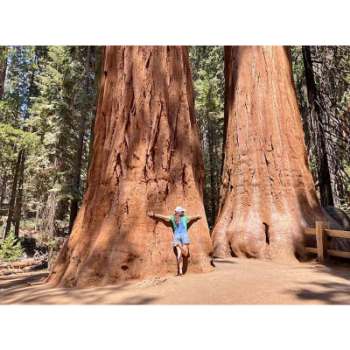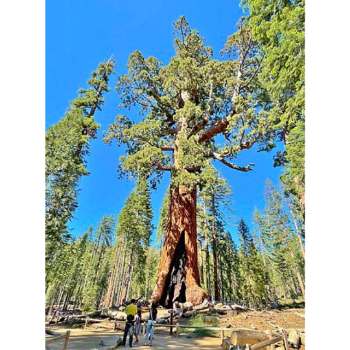Sequoia trees, like huge redwoods are important and they need to be protected because they only grow on the west coast of the United States, mostly in hilly areas from central California to Oregon. Only about 5–10% of these beautiful trees still stand because people have cut down so many plants.
The fact that just 5–10% of the very vast area that these enormous redwoods covered is still intact now is concerning. Unfortunately, humans is mostly to blame for this downfall. Their population has suffered greatly as a result of human activity, notably widespread logging. For instance, we have seen these wonderful trees almost entirely eradicated in Oregon. They now only have a presence in the state of California, which is their final remaining bastion.
This decrease has a variety of effects. In addition to being amazing natural marvels, sequoia trees are also keystone species that have a substantial impact on the health of their ecosystem. They maintain biodiversity by acting as homes for numerous plants and species. Their enormous size also makes it possible for them to store large volumes of carbon dioxide, which helps to prevent climate change.
Additionally, their ability to absorb and store large amounts of carbon dioxide helps mitigate climate change by reducing greenhouse gas emissions. Protecting sequoia trees is vital for preserving the natural world and ensuring a sustainable future for generations to come.
The Ecological Significance Of Sequoia Trees
Sequoia trees are of immense ecological significance due to their role as carbon sinks. These majestic giants have the ability to absorb and store substantial amounts of carbon dioxide from the atmosphere, thereby contributing to the fight against climate change.
Moreover, sequoia groves support rich biodiversity, providing a home to a multitude of plant and animal species. The dense and ancient forests created by sequoias foster a delicate balance and stability within ecosystems, promoting healthy and resilient habitats. These trees, with their towering presence, play a crucial role in regulating local climates, preventing soil erosion, and purifying the air we breathe.
Table of Contents
It is imperative that we take measures to protect and preserve these remarkable trees, ensuring their survival for future generations to come. By safeguarding sequoia trees, we are safeguarding the health and well-being of our planet as a whole.
The Economic Importance Of Sequoia Trees
Sequoia trees hold significant economic importance, making it crucial to protect these majestic giants. These towering trees attract tourists from all over the world, boosting local economies through revenue generation. Additionally, sequoias provide timber and forest products that contribute to the economic growth of surrounding communities.
The tourism industry relies on the allure of these awe-inspiring trees, attracting visitors who in turn support local businesses. Furthermore, the timber from sequoia trees is harvested sustainably, creating jobs and stimulating the local economy. Protecting sequoias ensures the continuity of these economic benefits, allowing future generations to enjoy the natural beauty and economic prosperity associated with these iconic trees.
Safeguarding these ancient giants is not only necessary for environmental preservation but also for the economic well-being of communities and the sustainability of industries dependent on sequoia-related activities.
The Cultural And Historical Significance Of Sequoia Trees
Sequoia trees hold immense cultural and historical significance due to their Native American connections and cultural importance. These majestic trees have deep roots in indigenous traditions and represent the historical connection between nature and Native American communities. Additionally, their conservation efforts have transformed sequoia groves into historical landmarks, attracting visitors from all over the world.
The symbolism associated with sequoia trees goes beyond their sheer size and age; they embody national pride and the resilience of the natural world. Through preservation and protection, sequoia trees continue to inspire and remind us of the importance of safeguarding our natural heritage for future generations.
Also Read : 30 Unbelievable Facts About Giant Sequoia Trees
Threats To Sequoia Tree Populations
Sequoia trees play a crucial role in our ecosystem due to their immense size and longevity. Unfortunately, these magnificent trees face various threats, including climate change and forest fires that have a direct impact on their populations. The rising temperatures and changing rainfall patterns associated with climate change disrupt the balance of these delicate ecosystems, making it challenging for sequoia trees to thrive.
Additionally, the increasing frequency and intensity of forest fires pose a significant risk to sequoia tree populations, as these trees are not adapted to withstand intense heat. Logging and deforestation are also contributing factors to the decline of sequoia trees, as they destroy the habitats and disrupt the natural processes that support their survival.
Furthermore, disease and pests pose a significant threat, as they weaken the trees’ defenses and make them more susceptible to damage. Protecting sequoia trees is vital for preserving biodiversity and the overall health of our planet’s forests.
Conservation Measures And Initiatives
Sequoia trees play a crucial role in our ecosystem and must be protected through various initiatives. Conservation measures are being implemented to ensure their preservation. Numerous organizations are actively involved in efforts to conserve these magnificent trees. Many protected areas and national parks have been established to safeguard their habitat.
Reforestation programs are also being carried out to restore Sequoia populations. It is vital to recognize the significance of these initiatives for the long-term survival of these trees. By protecting Sequoia trees, we preserve not only their majestic beauty but also the biodiversity they support.
Sustainable management and conservation efforts are necessary to ensure the continued existence of these exceptional and vital species. Safeguarding Sequoia trees is our responsibility, and it is crucial that we take action to protect them for future generations.
Benefits Of Protecting Sequoia Trees
Sequoia trees play a vital role in mitigating climate change by sequestering carbon dioxide. They act as a natural carbon sink, absorbing large amounts of CO2 and releasing oxygen into the atmosphere. Protecting these majestic trees helps in reducing the impact of greenhouse gases and stabilizing climate patterns.
In addition to mitigating climate change, sequoia trees also contribute to maintaining biodiversity and providing essential ecosystem services. They provide habitat for numerous plant and animal species, promoting a rich and diverse ecosystem. Furthermore, these ancient trees hold cultural significance, representing a connection to our past and national identity.
Preserving sequoia trees ensures that future generations can appreciate their beauty and understand the importance of ecological conservation. By protecting these valuable trees, we are actively participating in the preservation of our environment and heritage.
The Role Of Public Awareness And Education
Public awareness and education play a vital role in protecting sequoia trees. Environmental education programs are essential in raising awareness about the importance of these trees. These programs inform communities about the significance of sustainable practices, promoting a sense of responsibility towards tree conservation.
When communities are involved in the conservation efforts, it fosters a collective commitment to safeguarding sequoia trees. By educating the public and promoting community involvement, we can ensure the protection and preservation of these magnificent and ecologically significant trees for future generations.
Frequently Asked Questions On Why Are Sequoia Trees Important To Protect?
Why Is It Important To Protect Sequoia?
Sequoias are crucial to protect because they hold immense ecological and cultural significance. These towering giants help combat climate change by absorbing and storing large amounts of carbon dioxide. By conserving sequoia forests, we can preserve vital habitats for countless species, supporting biodiversity and maintaining the delicate balance of ecosystems.
Additionally, sequoias promote clean air and water by acting as natural filters. These majestic trees also inspire awe and wonder, drawing visitors from around the world and contributing to local economies through tourism. Protecting sequoias ensures that future generations can experience their grandeur and learn from their immense history.
By safeguarding these iconic trees, we can make a positive impact on our environment, as well as preserve a piece of our natural heritage.
Why Are The Sequoia Trees So Important?
Sequoia trees are important due to their unique qualities and ecological significance. These trees, also known as redwoods, are the largest and tallest on the planet. They can reach heights of over 300 feet and live for thousands of years.
This makes them vital for maintaining biodiversity and providing habitats for various plant and animal species. Sequoias also play a crucial role in combating climate change by absorbing significant amounts of carbon dioxide, a greenhouse gas that contributes to global warming.
Moreover, their dense forests act as carbon sinks, storing carbon for long periods. In addition to their ecological importance, sequoias are revered for their cultural and historical significance. They have become iconic symbols of strength, resilience, and natural beauty. Preserving these majestic trees is essential for maintaining the balance of our ecosystems and protecting our natural heritage.
Why Are Sequoia Trees Important For The Environment?
Sequoia trees play a vital role in the environment by acting as carbon sinks, absorbing and storing large amounts of carbon dioxide. They also provide habitat for various animal species and contribute to maintaining a balanced ecosystem.
What Makes Sequoia Trees Resilient?
Sequoia trees have adapted to thrive in harsh conditions, with their thick bark protecting them from fire, insects, and disease. They also have the ability to regenerate after disturbances, making them resilient to environmental changes.
Conclusion
Sequoia trees are undeniably important to protect due to their numerous benefits and ecological significance. As the tallest and oldest living organisms on the planet, these towering giants play a crucial role in maintaining the earth’s biodiversity and combating climate change.
Their sheer size allows them to absorb more carbon dioxide than any other tree species, mitigating the impact of greenhouse gases and helping to stabilize the climate. Furthermore, sequoias provide habitat for countless species, preserving and supporting diverse ecosystems. Their expansive roots also prevent soil erosion while their fallen trunks serve as nutrient-rich homes for various organisms.
Beyond their ecological importance, these majestic trees hold cultural and recreational value, attracting visitors and generating revenue for local economies. Protecting sequoia trees ensures that future generations can continue to experience their awe-inspiring beauty and reap the ecological benefits they provide.
Let us stand together in safeguarding these iconic giants for the betterment of our planet and its inhabitants.


